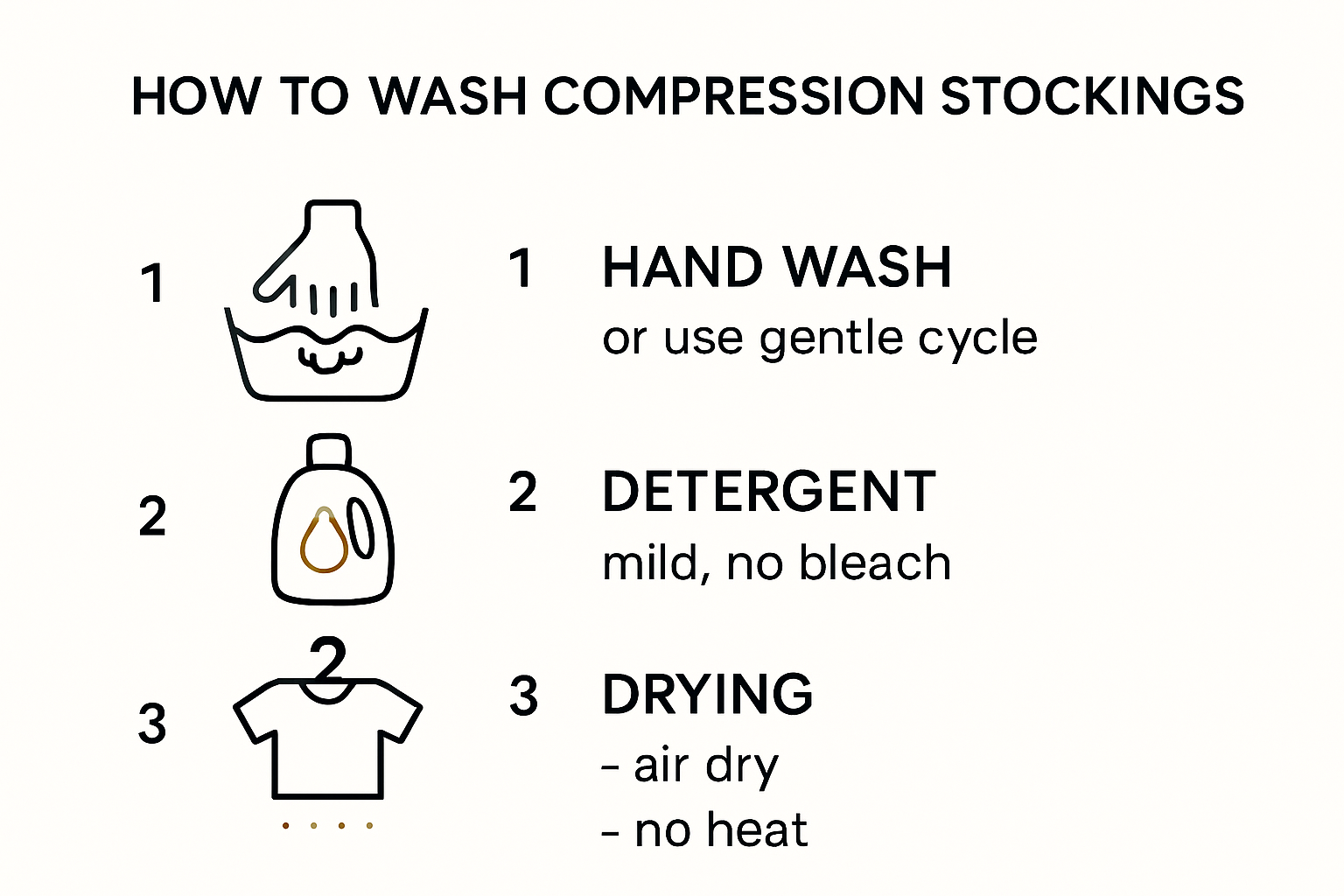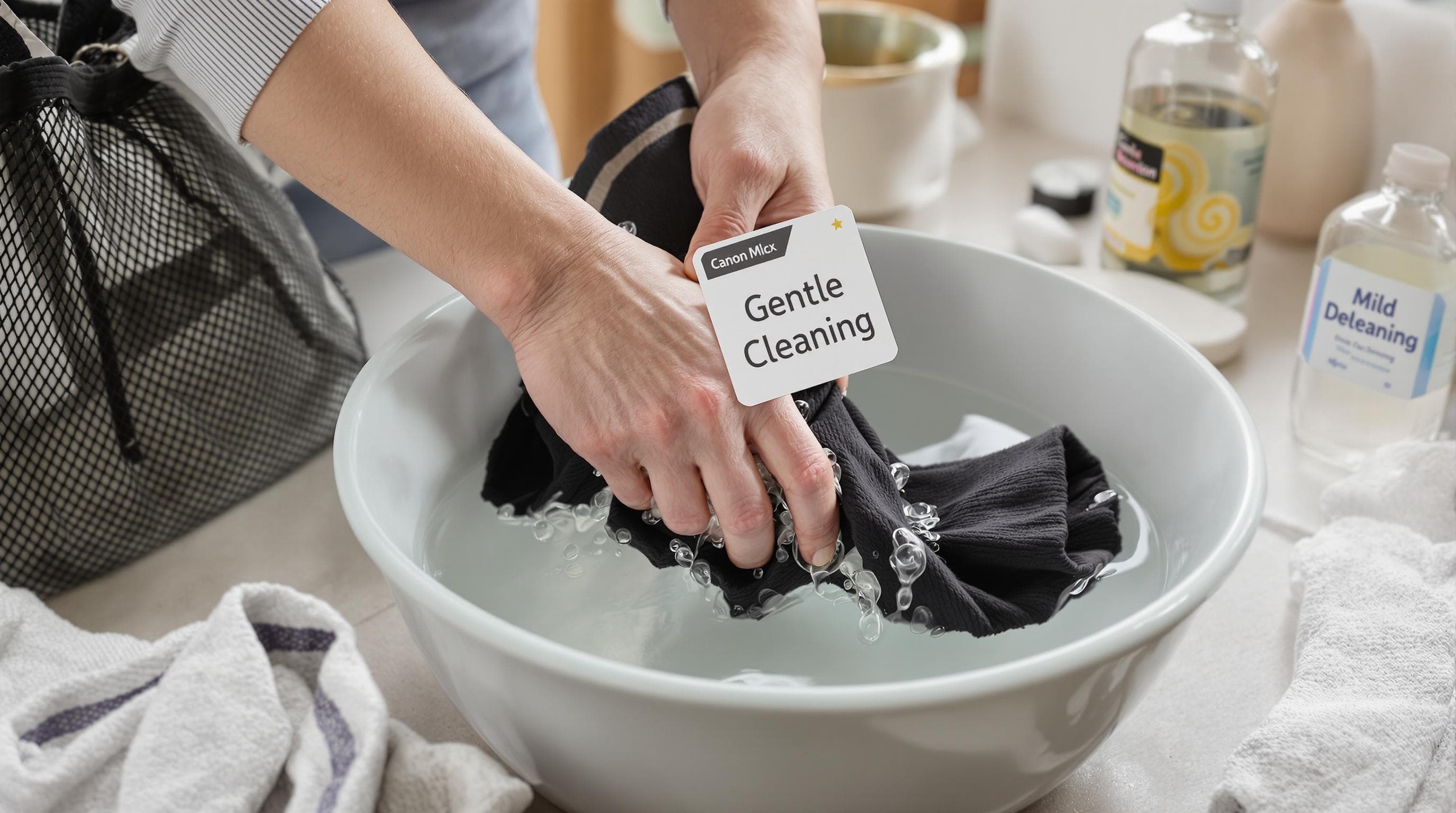
Washing Compression Stockings: Best Practices for 2025
Share

Washing compression stockings might seem like a simple chore at first glance. Think again. Studies show that improper cleaning can reduce their effectiveness by up to 40 percent, risking both your health and wallet. The real surprise is that quick shortcuts, like using hot water or tossing them in the dryer, actually do more harm than good and could cut their lifespan in half.
Table of Contents
- Why Proper Washing Matters For Compression Stockings
- Step-By-Step Guide To Washing Compression Stockings
- Dos And Don’ts For Everyday Care
- Drying And Storing Compression Stockings Safely
Quick Summary
| Takeaway | Explanation |
|---|---|
| Preserve Compression Effectiveness | Regular washing removes dirt and sweat, maintaining the fabric’s elasticity and therapeutic support. |
| Follow Precise Washing Techniques | Use mild detergent and avoid high temperatures; hand washing or a delicate machine cycle is recommended. |
| Avoid Heat During Drying | Air dry compression stockings flat and avoid direct sunlight or heat sources to preserve their functionality. |
| Inspect Regularly for Wear | Check for damage or loss of elasticity; replace every 3 to 6 months to ensure optimal performance. |
| Store Properly | Keep stockings in a cool, dry place, avoiding folds or heavy compression to maintain their integrity. |

Why Proper Washing Matters for Compression Stockings
Compression stockings are sophisticated medical garments designed to support circulation and manage various health conditions. Proper washing isn’t just about cleanliness - it’s a critical maintenance strategy that directly impacts the garment’s performance, longevity, and your health.
Preserving Compression Effectiveness
The intricate elastic fibers in compression stockings require careful handling to maintain their therapeutic compression levels. Research from the Mayo Clinic emphasizes that sweat, dirt, and body oils can progressively degrade the fabric’s structural integrity. When these contaminants accumulate, they compromise the stocking’s ability to provide consistent pressure and support. Regular washing removes these elements, ensuring the garment continues to deliver its intended medical benefits.
Medical-grade compression stockings are engineered with specialized materials that require precise cleaning techniques. Improper washing can cause significant damage to the fabric’s elasticity, reducing the garment’s ability to provide graduated compression. This means your stockings might lose their therapeutic effectiveness faster than expected, potentially impacting your treatment or recovery.
Preventing Hygiene and Health Risks
According to medi, a medical compression product manufacturer, daily washing is crucial for both hygienic reasons and maintaining material performance. Compression stockings are in direct contact with your skin, making them susceptible to bacterial growth, odor development, and potential skin irritation. These garments trap moisture and can become breeding grounds for microorganisms if not cleaned regularly.
The accumulation of bacteria, dead skin cells, and perspiration can lead to several health concerns. Unwashed compression stockings might cause:
- Skin infections: Bacterial buildup can cause rashes or fungal growth
- Odor problems: Persistent unpleasant smells from trapped moisture
- Reduced breathability: Blocked fabric pores decrease moisture-wicking capabilities
Extending Garment Lifespan
Proper washing isn’t just about immediate cleanliness - it’s an investment in your compression stockings’ long-term performance. Healthcare education provider Ausmed recommends washing stockings every three days or immediately when soiled. By following precise washing guidelines, you can significantly extend the life of these often expensive medical garments.
The right washing technique prevents premature fabric degradation. Avoiding high temperatures, harsh detergents, and mechanical stress during cleaning helps maintain the stocking’s original elasticity and compression properties. This careful maintenance ensures you get the maximum therapeutic value and financial return from your compression stockings.
For more comprehensive insights, explore our detailed guide on compression stocking care.
Step-by-Step Guide to Washing Compression Stockings
Washing compression stockings requires precision and care to maintain their therapeutic effectiveness and extend their lifespan. Following a systematic approach ensures your medical garments remain clean, functional, and comfortable.
Preparing for Washing
Before starting the washing process, gather your materials carefully. The Guy’s and St Thomas’ NHS Foundation Trust recommends preparing mild detergent specifically designed for delicate fabrics. Avoid harsh chemicals that can break down the elastic fibers. Inspect your stockings for any visible damage or wear before washing, as this could impact the cleaning process.
Separate your compression stockings from other laundry items. This prevents potential snagging or damage from zippers, buttons, or rough fabric textures. If you have multiple pairs, wash them individually or with similar colored compression garments to prevent color transfer or potential fabric degradation.
Hand Washing and Machine Cleaning Techniques
Sigvaris recommends two primary washing methods: hand washing and gentle machine cleaning. For hand washing, use lukewarm water and a mild detergent. Turn the stockings inside out to protect the external surface and ensure thorough cleaning. Gently massage the fabric without wringing or twisting, which can damage the elastic fibers.
If using a washing machine, select the most delicate cycle available. Medi, a medical compression product manufacturer, advises washing at temperatures between 30-40 degrees Celsius and spinning at a maximum of 1,200 revolutions per minute. Use a mesh laundry bag for additional protection, and avoid fabric softeners that can break down the compression material.

Drying and Post-Wash Care
Drying compression stockings requires careful attention. Never use a tumble dryer or place them near direct heat sources like radiators. Our comprehensive guide on compression stocking maintenance emphasizes air drying as the optimal method. Lay the stockings flat on a clean towel, reshaping them gently to maintain their original form.
Avoid direct sunlight, which can degrade the fabric’s elasticity. Patience is key - allow the stockings to dry naturally at room temperature. Once completely dry, store them in a cool, dry place away from direct heat or sunlight. Proper storage helps maintain their compression properties and extends their functional lifespan.
Remember, each washing cycle slightly reduces the elasticity of compression stockings. Rotating between multiple pairs and following these precise cleaning instructions will help you maximize their performance and durability.
Here is a table summarizing the recommended hand and machine washing techniques for compression stockings, making it easy to compare the key steps and best practices for each method:
| Method | Water Temperature | Detergent Type | Special Instructions |
|---|---|---|---|
| Hand Washing | Lukewarm | Mild, for delicates | Turn inside out, gently massage, avoid wringing or twisting |
| Machine Washing | 30–40°C (86–104°F) | Mild, for delicates | Use delicate cycle, mesh laundry bag, max 1,200 rpm, avoid fabric softener |
Dos and Don’ts for Everyday Care
Compression stockings are sophisticated medical garments that require thoughtful daily management to maintain their effectiveness and extend their lifespan. Understanding the right practices can significantly impact their performance and your overall comfort.
Proper Wear and Handling
According to Kaiser Permanente, wearing compression stockings correctly is as crucial as washing them properly. Always put them on first thing in the morning when leg swelling is minimal. Smooth them carefully to ensure they lie flat against the skin without bunching or creating wrinkles that could restrict circulation.
Do:
- Inspect stockings daily for signs of wear or damage
- Handle gently when putting on and taking off
- Store in a cool, dry place away from direct sunlight
- Use rubber gloves when putting on to prevent fingernail tears
Don’t:
- Never roll or bunch the stockings when putting them on
- Avoid wearing them while sleeping
- Do not fold or crease when storing
- Never use sharp objects near the stockings
For quick reference, the following table provides a clear overview of essential Do’s and Don’ts for daily care and handling of compression stockings:
| Action | Do / Don’t | Purpose / Reason |
|---|---|---|
| Inspect stockings daily | Do | Detect wear or damage early |
| Handle gently (putting on/off) | Do | Prevent tearing or overstretching |
| Store in cool, dry place | Do | Preserve elasticity and avoid damage |
| Use rubber gloves to put on | Do | Prevent fingernail or jewelry tears |
| Roll or bunch when putting on | Don’t | Can restrict circulation or damage fabric |
| Wear while sleeping | Don’t | Not recommended unless prescribed |
| Fold or crease when storing | Don’t | Can cause permanent marks and reduce elasticity |
| Use sharp objects near stockings | Don’t | Risk of punctures or tears |
Maintenance and Replacement Guidelines
WebMD recommends replacing compression stockings every 3 to 6 months to ensure optimal performance. The elasticity of these garments gradually diminishes with repeated use and washing. Pay close attention to signs of wear such as thinning fabric, loss of compression, or visible stretching.
Regular maintenance involves more than just washing. Rotate between multiple pairs if possible to reduce wear on a single garment. Check out our comprehensive guide on compression stocking maintenance for more detailed insights into prolonging their effectiveness.
Warning Signs and Professional Consultation
Be vigilant about potential issues with your compression stockings. Watch for these critical warning signs that might indicate a problem:
- Extreme discomfort or pain while wearing
- Unusual skin discoloration around the stocking area
- Significant changes in the stocking’s texture or elasticity
- Visible tears or holes in the fabric
If you experience persistent discomfort or notice any of these signs, consult your healthcare provider immediately. Not all compression stockings are created equal, and individual medical needs vary. Professional guidance ensures you’re using the most appropriate garment for your specific health condition.
Remember, compression stockings are a medical tool, not just a piece of clothing. Treating them with care, following proper maintenance protocols, and staying attentive to their condition will help you maximize their therapeutic benefits and protect your investment in your health.
Drying and Storing Compression Stockings Safely
Proper drying and storage are critical aspects of compression stocking maintenance that directly impact their performance, longevity, and therapeutic effectiveness. Understanding the nuanced techniques for preserving these specialized medical garments can significantly extend their functional lifespan.
Optimal Drying Techniques
InformedHealth.org emphasizes the importance of avoiding tumble drying, which can irreparably damage the delicate elastic fibers of compression stockings. Instead, opt for air drying at room temperature. Lay the stockings flat on a clean, dry towel, carefully reshaping them to maintain their original form and compression properties.
Key drying principles include:
- Avoid direct heat sources: Keep stockings away from radiators, direct sunlight, and heat vents
- Use a flat surface: Spread stockings evenly to prevent stretching or misshaping
- Prevent wringing: Never twist or wring out stockings, as this can damage their elastic structure
- Patience is crucial: Allow complete air drying before wearing or storing
Storage Best Practices
U.S. Pharmacist recommends meticulous storage to preserve compression stocking integrity. After ensuring they are completely dry, store them in a cool, dry place away from direct sunlight and extreme temperatures. Use a dedicated drawer or storage container that prevents crushing or unnecessary compression.
Ideal storage conditions include:
- Separate compartments: Store each pair individually to prevent snagging
- Avoid folding: Keep stockings as flat as possible
- Temperature control: Maintain a consistent, moderate room temperature
- Protect from dust: Consider using breathable fabric bags for additional protection
Long-Term Maintenance and Replacement
Explore our comprehensive guide to compression stocking care for deeper insights into maintaining these critical medical garments. Professional healthcare providers typically recommend replacing compression stockings every six months to ensure consistent therapeutic compression.
Warning signs that indicate immediate replacement include:
- Visible thinning of fabric
- Loss of original elasticity
- Permanent stretching or deformation
- Visible holes or significant wear
- Reduced compression effectiveness
Compression stockings are precision medical devices. Their performance directly impacts your circulatory health, so treating them with careful attention to drying and storage is not just about maintenance - it’s about preserving a critical tool in your healthcare routine.
Remember, each pair of compression stockings represents an investment in your health. By following these precise drying and storage guidelines, you ensure maximum longevity, consistent performance, and optimal therapeutic benefits.
Frequently Asked Questions
How often should I wash my compression stockings?
You should wash your compression stockings every day or at least every three days, especially if they are soiled. Regular washing helps maintain their elasticity and effectiveness.
What is the best way to wash compression stockings?
The best way to wash compression stockings is by hand in lukewarm water with a mild detergent. If machine washing, use a delicate cycle and place them in a mesh laundry bag.
Can I put compression stockings in the dryer?
No, you should never put compression stockings in the dryer as heat can damage the elastic fibers. Instead, air dry them flat away from direct sunlight or heat sources.
How can I tell if my compression stockings need to be replaced?
You should replace your compression stockings every 3 to 6 months or sooner if you notice signs of wear, such as thinning fabric, loss of elasticity, or visible tears.
Protect Your Compression Investment With Fit Stockings
You have just learned how crucial proper washing and maintenance are to the effectiveness and lifespan of your compression stockings. Even with the best cleaning habits, everyday wear and washing can still lead to loss of elasticity and support. If you rely on your stockings for relief from varicose veins, lymphedema, or diabetes-related swelling, keeping a fresh, supportive pair is not just about comfort—it is about your health.
Looking for a replacement or need a backup to follow the recommended care routine from this article? Explore our curated selection of Jobst medical compression stockings, trusted by customers for their quality and durability. Shop by style and compression level to find the best match for your personal needs, or visit Fit Stockings for even more expert support and free shipping options. Take control of your leg health now and make every day count—shop quality compression solutions that last.
Recommended
- Compression Stockings and Diabetes: What to Know in 2025 – Fit Stockings
- The Ultimate Guide to Compression Stockings: Comfort, Health, and Styl – Fit Stockings
- Compression Stockings for Elderly: 2025 Guide to Healthier Legs – Fit Stockings
- Fashionable Compression Stockings: Stylish Support for 2025 – Fit Stockings

